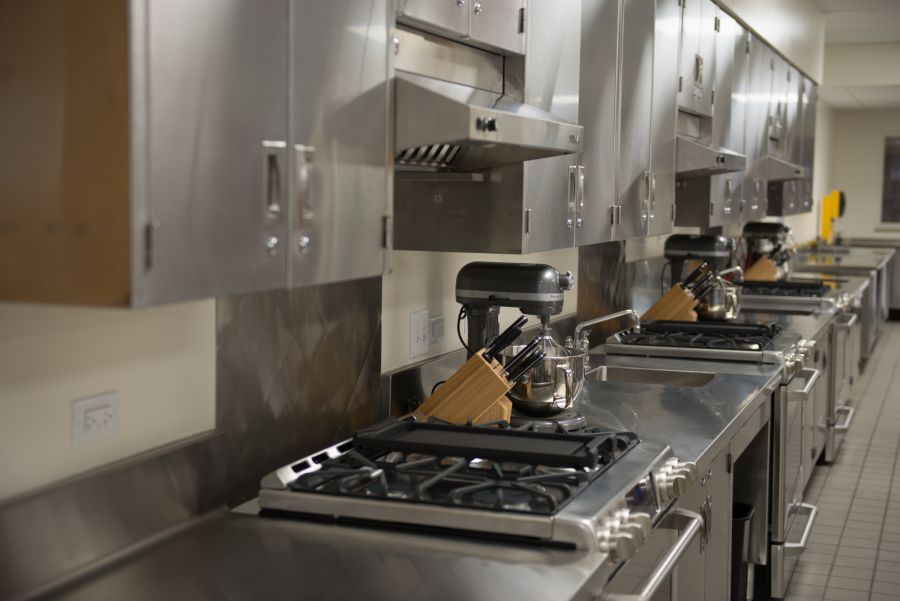Smooth milk cascaded into a metal bowl so shiny it reflected the gentle movement of Rachel Vollmer as she slowly poured. Turning on the mixer, Vollmer leaned her hand against the cool surface of a new stove nearby, standing at one of a half-dozen cooking stations in the spacious, new Food Science Lab at Illinois State University.
“This place is incredible, and it is just what the students need,” said Vollmer, an assistant professor of Family and Consumer Sciences (FCS).
For those who remember the old foods lab, the new digs are a far cry from the gold and green linoleum—and the original intent—of the past lab. “This lab was first developed as a way to prepare people—prepare women—to be homemakers, so everything resembled a small, residential kitchen,” said FCS Chairperson Ani Yazedjian. “Now you are looking at something you would see in large-scale restaurants, health-care facilities, and hospitals. We’re preparing students for the changing food industry.”
The new lab includes commercial-quality stoves and dishwashing area. State-of-the-art cameras run throughout the lab, so instructors can display stations for all students to see on a large screen. “We’ll also have the capability of showing stations side-by-side and recording classes for online teaching and demonstration,” said Yazedjian. All tables and prep carts are on rollers, so the room can be rearranged to suit the various classes that will return to the lab this fall. The yearlong project is estimated at more than $750,000, funded by an allocation from the University’s Board of Trustees and from the College of Applied Science and Technology.
The upgrades reflect how the food industry has evolved over the last decade, said Nancy Koch, an FCS instructor who will teach in the lab. “This gives students the opportunity to work in a facility that is more up to code in terms of equipment, and realistic in feel to what they will see in the industry,” she said. Yazedjian added the boom in eating out follows family trends. “It used to be a big deal to get dressed up and go out to eat, but there are so many families where everyone is working, and so many activities in which everyone is involved, that eating out has become a commonplace event.”
That shift sparked the development of a new option in FCS called Food and Nutrition Management that also began last year. “The industry is not what it was 10 years ago,” said Yazedjian. “Along with having some background in business, managers need to have some understanding of the kitchen and dietary needs.” The option focuses on diet, much like the sequence for registered dietitians, but also includes a food management element that is desired in the marketplace.
“There is a big push for restaurants and commercial kitchens to cater to the dietary needs of clients,” said Vollmer, as she poured a mixture into the ice cream maker. “It’s more than simply allergies, although those are important. It’s about understanding dietary challenges.” Yazedjian looked to the aging Baby Boomer population as an example. “As people get older, they tend to lose taste buds and salt their food more to get flavor,” she said. “We need to find ways to add flavor without elevating their sodium intake.”
Pointing to several batches of finished ice cream, Vollmer explained the tasty treat is actually a project for students. “They have to alter a basic recipe by substituting a possible challenge. In this case, they have to swap out the milk.” Next to several cups of creamy strawberry ice cream sit a darker, icier blend. “Some try cashew milk,” she said, scooping up a bit with a tiny, plastic spoon, “but they find out pretty quickly the fat and the protein contribute to the smooth mouth feel.”
It won’t just be FCS students who benefit from the new Food Science Lab. Yazedjian sees the lab as a community resource. “There are community groups we could not accommodate before because we did not have the space. So whether it is chefs teaching families how to cook around allergies, or a troop of Boy Scouts earning a badge, this would provide them with a place.”


